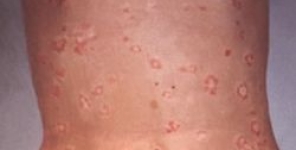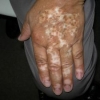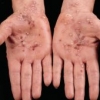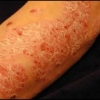Principali determinanti della lunghezza del periodo di remissione nella psoriasi volgare, dopo una terapia topica con NB-UVB e PUVA: uno studio di follow-up
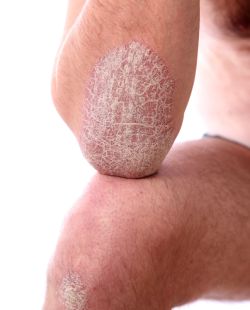 I periodi di remissione e di esacerbazione delle lesioni psoriasiche sono comuni nella psoriasi. Abbiamo recentemente riferito di come la proteina C reattiva (CRP) sia un marker di gravità della psoriasi e di come alcuni pazienti presentino un'infiammazione residua anche dopo il trattamento. Ci siamo quindi chiesti se questa infiammazione residua fosse alla base di un aggravamento precoce della psoriasi.
I periodi di remissione e di esacerbazione delle lesioni psoriasiche sono comuni nella psoriasi. Abbiamo recentemente riferito di come la proteina C reattiva (CRP) sia un marker di gravità della psoriasi e di come alcuni pazienti presentino un'infiammazione residua anche dopo il trattamento. Ci siamo quindi chiesti se questa infiammazione residua fosse alla base di un aggravamento precoce della psoriasi.
Obiettivo: Lo scopo del nostro studio è stato quello di valutare se c'è una relazione tra i livelli di CRP, l'Indice di Area e Gravità della Psoriasi (PASI), e l'Indice di Massa Corporea (BMI) al termine del trattamento per la psoriasi, con la lunghezza di remissione della psoriasi stessa.
Metodi: Abbiamo seguito 46 pazienti, che sono poi stati studiati alla fine del trattamento per registrare la durata della remissione; 9 di questi pazienti sono stati trattati con agenti topici, 17 con UVB a banda stretta (NB-UVB), e 20 con psoralene + UVA (PUVA).
Risultati: Abbiamo trovato che la lunghezza di remissione è correlata con i valori di CRP e PASI, alla fine della terapia. Con l'esecuzione di un'analisi di regressione lineare multipla, CRP, PASI, e BMI sono stati associati significativamente con la lunghezza di remissione. Pazienti con un'infiammazione residua al termine del trattamento hanno presentato una lunghezza significativamente più breve del periodo di remissione. Quando si sono considerati i pazienti, raggruppati secondo le terapie usate, CRP e PASI sono emersi come potenziali determinanti della lunghezza di remissione, soprattutto nel caso di pazienti trattati con NB-UVB e terapia topica.
Conclusioni: I nostri dati suggeriscono che CRP e PASI sono determinanti importanti della durata di remissione della psoriasi nei pazienti trattati con fototerapia o con terapia topica. Sono necessari ulteriori studi, con gruppi più grandi di pazienti, per verificare questa ipotesi. Inoltre prevediamo che, alla fine del trattamento, la valutazione di CRP e PASI potrebbe essere importante per decidere, quando possibile, se il trattamento deve essere continuato per ottenere bassi valori di CRP e lunghi periodi di remissione.
Storia della pubblicazione:
Titolo: Principal Determinants of the Length of Remission of Psoriasis Vulgaris After Topical, NB-UVB, and PUVA Therapy: A Follow-Up Study
Rivista: American Journal of Clinical Dermatology: published online before print, 28 November 2012.doi: 10.1007/s40257-012-0002-8
Autori: Coimbra, Susana; Oliveira, Hugo; Belo, Luís; Figueiredo, Américo; Rocha-Pereira, Petronila; Santos-Silva, Alice
Affiliazioni:
Abstract:
Background: Periods of remission and of exacerbation of psoriatic lesions are common in psoriasis. We recently reported C-reactive protein (CRP) as a marker of psoriasis severity and that some patients still presented with a residual inflammation after treatment. We wondered if this residual inflammation could underlie an earlier exacerbation of psoriasis.
Objective: The purpose of our study was to evaluate if there is a relationship between CRP levels, Psoriasis Area and Severity Index (PASI), and body mass index (BMI), at the end of psoriasis treatment, with the length of psoriasis remission.
Methods: We followed 46 patients studied at the end of treatment, to record the length of remission; 9 of the patients were treated with topical agents, 17 with narrow-band UVB (NB-UVB), and 20 with psoralen plus UVA (PUVA).
Results: We found that the length of remission correlated with the values for PASI and CRP at the end of therapy. By performing a multiple linear regression analysis, CRP, PASI, and BMI were each significantly associated with length of remission. Patients with residual inflammation at the end of treatment presented with a significantly shorter length of remission. When considering patients grouped according to the used therapies, CRP and PASI also emerged as potential determinants of length of remission, especially in the case of patients treated with NB-UVB and topical therapy.
Conclusion: Our data suggest that CRP and PASI are important determinants of length of psoriasis remission for patients treated with phototherapy or topical therapy. Further studies with larger groups of patients are warranted to test this hypothesis. Moreover, we propose that, by the end of the treatment, the evaluation of CRP and PASI could be important to decide, when possible, if the treatment should be continued to achieve lower CRP values and longer periods of remission.
